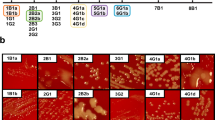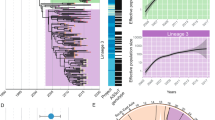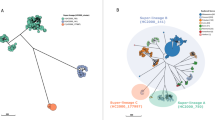Abstract
Host adaptation is a key factor contributing to the emergence of new bacterial, viral and parasitic pathogens. Many pathogens are considered promiscuous because they cause disease across a range of host species, while others are host-adapted, infecting particular hosts1. Host adaptation can potentially progress to host restriction, where the pathogen is strictly limited to a single host species and is frequently associated with more severe symptoms. Host-adapted and host-restricted bacterial clades evolve from within a broader host-promiscuous species and sometimes target different niches within their specialist hosts, such as adapting from a mucosal to a systemic lifestyle. Genome degradation, marked by gene inactivation and deletion, is a key feature of host adaptation, although the triggers initiating genome degradation are not well understood. Here, we show that a chronic systemic non-typhoidal Salmonella infection in an immunocompromised human patient resulted in genome degradation targeting genes that are expendable for a systemic lifestyle. We present a genome-based investigation of a recurrent blood-borne Salmonella enterica serotype Enteritidis (S. Enteritidis) infection covering 15 years in an interleukin-12 β1 receptor-deficient individual that developed into an asymptomatic chronic infection. The infecting S. Enteritidis harboured a mutation in the mismatch repair gene mutS that accelerated the genomic mutation rate. Phylogenetic analysis and phenotyping of multiple patient isolates provides evidence for a remarkable level of within-host evolution that parallels genome changes present in successful host-restricted bacterial pathogens but never before observed on this timescale. Our analysis identifies common pathways of host adaptation and demonstrates the role that immunocompromised individuals can play in this process.
This is a preview of subscription content, access via your institution
Access options
Subscribe to this journal
Receive 12 digital issues and online access to articles
$119.00 per year
only $9.92 per issue
Buy this article
- Purchase on Springer Link
- Instant access to full article PDF
Prices may be subject to local taxes which are calculated during checkout



Similar content being viewed by others
References
Baumler, A. & Fang, F. C. Host specificity of bacterial pathogens. Cold Spring Harb. Perspect. Med. 3, a010041 (2013).
Parkhill, J. et al. Complete genome sequence of a multiple drug resistant Salmonella enterica serovar Typhi CT18. Nature 413, 848–852 (2001).
McClelland, M. et al. Comparison of genome degradation in Paratyphi A and Typhi, human-restricted serovars of Salmonella enterica that cause typhoid. Nature Genet. 36, 1268–1274 (2004).
Zhou, Z. et al. Transient Darwinian selection in Salmonella enterica serovar Paratyphi A during 450 years of global spread of enteric fever. Proc. Natl Acad. Sci. USA 111, 12199–12204 (2014).
Holt, K. E. et al. Pseudogene accumulation in the evolutionary histories of Salmonella enterica serovars Paratyphi A and Typhi. BMC Genomics 10, 36 (2009).
Celum, C. L., Chaisson, R. E., Rutherford, G. W., Barnhart, J. L. & Echenberg, D. F. Incidence of salmonellosis in patients with AIDS. J. Infect. Dis. 156, 998–1002 (1987).
De Beaucoudrey, L. et al. Revisiting human IL-12Rβ1 deficiency: a survey of 141 patients from 30 countries. Medicine 89, 381–402 (2010).
MacLennan, C. et al. Interleukin (IL)-12 and IL-23 are key cytokines for immunity against Salmonella in humans. J. Infect. Dis. 190, 1755–1757 (2004).
Altare, F. et al. Impairment of mycobacterial immunity in human interleukin-12 receptor deficiency. Science 280, 1432–1435 (1998).
Okoro, C. K. et al. Intracontinental spread of human invasive Salmonella Typhimurium pathovariants in sub-Saharan Africa. Nature Genet. 44, 1215–1221 (2012).
Mather, A. E. et al. Distinguishable epidemics of multidrug-resistant Salmonella Typhimurium DT104 in different hosts. Science 341, 1514–1517 (2013).
Schaaper, R. M. Base selection, proofreading, and mismatch repair during DNA replication in Escherichia coli. J. Biol. Chem. 268, 23762–23765 (1993).
Denamur, E. & Matic, I. Evolution of mutation rates in bacteria. Mol. Microbiol. 60, 820–827 (2006).
Funchain, P. et al. The consequences of growth of a mutator strain of Escherichia coli as measured by loss of function among multiple gene targets and loss of fitness. Genetics 154, 959–970 (2000).
Rocha, E. P. C. et al. Comparisons of dN/dS are time dependent for closely related bacterial genomes. J. Theor. Biol. 239, 226–235 (2006).
Kingsley, R. A. et al. Genome and transcriptome adaptation accompanying emergence of the definitive type 2 host-restricted Salmonella enterica serovar Typhimurium pathovar. mBio 4, e00565-13 (2013).
Nuccio, S. P. & Baumler, A. J. Comparative analysis of Salmonella genomes identifies a metabolic network for escalating growth in the inflamed gut. mBio 5, e00929-14 (2014).
Kingsley, R. A. et al. Epidemic multiple drug resistant Salmonella Typhimurium causing invasive disease in sub-Saharan Africa have a distinct genotype. Genome Res. 19, 2279–2287 (2009).
Gong, J. et al. Spontaneous conversion between mutL and 6 bpΔmutL in Salmonella typhimurium LT7: association with genome diversification and possible roles in bacterial adaptation. Genomics 90, 542–549 (2007).
Thomson, N. R. et al. Comparative genome analysis of Salmonella Enteritidis PT4 and Salmonella Gallinarum 287/91 provides insights into evolutionary and host adaptation pathways. Genome Res. 18, 1624–1637 (2008).
SMALT v.0.7.4 (The Wellcome Trust Sanger Institute); http://www.sanger.ac.uk/science/tools/smalt-0
Kurtz, S. et al. Versatile and open software for comparing large genomes. Genome Biol. 5, R12 (2004).
Kurtz, S. et al. REPuter: the manifold applications of repeat analysis on a genomic scale. Nucleic Acids Res. 29, 4633–4642 (2001).
Holt, K. E. et al. High-throughput sequencing provides insights into genome variation and evolution in Salmonella Typhi. Nature Genet. 40, 987–993 (2008).
He, M. et al. Evolutionary dynamics of Clostridium difficile over short and long time scales. Proc. Natl Acad. Sci. USA 107, 7527–7532 (2010).
Stamatakis, A. RAxML-VI-HPC: maximum likelihood-based phylogenetic analyses with thousands of taxa and mixed models. Bioinformatics 22, 2688–2690 (2006).
Zerbino, D. & Birney, E. Velvet: algorithms for de novo short read assembly using de Bruijn graphs. Genome Res. 18, 821–829 (2008).
BEAST v.1.7.5 (University of Edinburgh); http://beast.bio.ed.ac.uk/
BEAGLE v.4 (University of Washington); https://faculty.washington.edu/browning/beagle/b3.html
HGAP v.3.0 (PacBio); https://github.com/PacificBiosciences/Bioinformatics-Training/wiki/HGAP
Otto, T. D., Dillon, G. P., Degrave, W. S. & Berriman, M. RATT: rapid annotation transfer tool. Nucleic Acids Res. 39, e57 (2011).
Carver, T. J. et al. ACT: the Artemis comparison tool. Bioinformatics 21, 3422–3423 (2005).
Alexa, A. & Rahnenfuhrer, J. R package version 2.20.0, topGO: Enrichment analysis for Gene Ontology (2010).
Huntley, R. P. et al. The GOA database: Gene Ontology annotation updates for 2015. Nucleic Acids Res. 43, D1057–D1063 (2015).
Tsai, C. M. & Frasch, C. E. A sensitive silver stain for detecting lipopolysaccharides in polyacrylamide gels. Anal. Biochem. 119, 115–119 (1982).
Acknowledgements
The authors thank D. Harris, G. Langridge and the Pathogen Informatics team for help with sequencing and bioinformatics and the Sanger Institute Research Support Facility for help with the animal studies. This work was funded by the Wellcome Trust through core funding for the Sanger Institute Pathogen Variation Group.
Author information
Authors and Affiliations
Contributions
R.A.K. and G.D. designed the study. E.J.K., D.K., R.D., A.C., A.M.L.L., J.H., R.A.K., E.G.K., J.H., J.F., S.C., L.K., S.K., D.G., T.W., C.H. and F.J.C. collected the data. E.J.K., R.A.K., T.D.O., J.F., J.P., S.H. and C.M. analysed the data. E.J.K., R.A.K., G.D., E.G.K. and J.P. wrote the manuscript.
Corresponding author
Ethics declarations
Competing interests
The authors declare no competing financial interests.
Supplementary information
Supplementary information
Supplementary Figures 1–10, Tables I–V, Discussion and References (PDF 3741 kb)
Rights and permissions
About this article
Cite this article
Klemm, E., Gkrania-Klotsas, E., Hadfield, J. et al. Emergence of host-adapted Salmonella Enteritidis through rapid evolution in an immunocompromised host. Nat Microbiol 1, 15023 (2016). https://doi.org/10.1038/nmicrobiol.2015.23
Received:
Accepted:
Published:
DOI: https://doi.org/10.1038/nmicrobiol.2015.23
This article is cited by
-
Staphylococcus aureus host interactions and adaptation
Nature Reviews Microbiology (2023)
-
Genomic adaptations of Campylobacter jejuni to long-term human colonization
Gut Pathogens (2021)
-
In vivo evolution of an emerging zoonotic bacterial pathogen in an immunocompromised human host
Nature Communications (2021)
-
Repurposing diphenylbutylpiperidine-class antipsychotic drugs for host-directed therapy of Mycobacterium tuberculosis and Salmonella enterica infections
Scientific Reports (2021)
-
Microevolution of Campylobacter jejuni during long-term infection in an immunocompromised host
Scientific Reports (2020)



